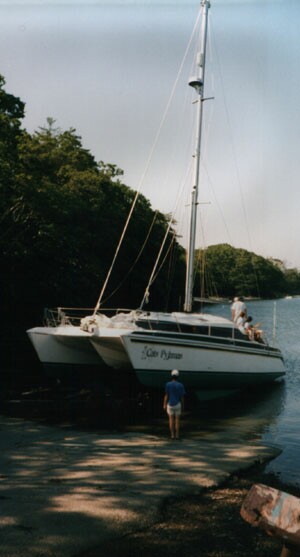Stripping Anti-fouling and re-applying it
 We experienced the first and only hull breach in the summer of 1998. Contrary to what one might think, the hulls are only 3/8" thick at the leading edge forward of the water tanks. When the boat hit some rocks off Pole Island, ME the starboard side was penetrated and the boat began to list at a 5 degree angle but remained fully functional. Much more worrisome was the hip fracture caused to a dear friend whose husband was skippering at the time. Switching the fresh-water selector to starboard and opening the taps had the desired effect of easing the list. We delivered our friend to a waiting ambulance, then pulled the boat.
We experienced the first and only hull breach in the summer of 1998. Contrary to what one might think, the hulls are only 3/8" thick at the leading edge forward of the water tanks. When the boat hit some rocks off Pole Island, ME the starboard side was penetrated and the boat began to list at a 5 degree angle but remained fully functional. Much more worrisome was the hip fracture caused to a dear friend whose husband was skippering at the time. Switching the fresh-water selector to starboard and opening the taps had the desired effect of easing the list. We delivered our friend to a waiting ambulance, then pulled the boat.
The leading edge is now stronger than it was before due to the epoxy and fiberglass we used to mend it. Furthermore, our boat was nearing the 10 year mark and while Prouts have not been known to suffer blister damage, the combination of a terrible first antifouling coat and the crash egged us on to do something better. While we had great success with our ACP-50 antifouling, the bad initial layer caused large bubbles to form under the ACP-50 that then flaked off. It would have been a lot easier to remove the bad antifouling back then and start anew rather than 8 years and many coats later on... live and learn. Any kind of impact can lead to pinholes opening up in the gel coat and the hull breach in 1998 was dramatic. We elected to remove the old antifouling down to the gel goat, to seal the entire underwater section with epoxy and to then re-apply antifouling.
It's a very messy job. We used the West Marine stripper system and heartily recommend plenty of drop cloths to capture drooping paint. Also, if the antifouling is thick, you'll need several iterations to remove it completely. The only quibbles we had with the West Marine stripper are that it did not apply very thickly and that it has to be covered immediately with the barrier layer so the solvents don't flash off. Furthermore, it did not tolerate direct exposure to sunlight in the summertime, drying and caking up instead.
After a week of struggle, the boat stood before us just as naked as when it was delivered to us. We painted the gel coat with several layers of white epoxy paint (the stuff is hard, sticks well, all while keeping water out) and used 3 layers of blue ACP-50 under the 5 green top layers so we can see when the antifouling needs topping off. Finally done, we collapsed in the heat.
Here she is in 1999, getting pushed into the cold waters of Maine.


